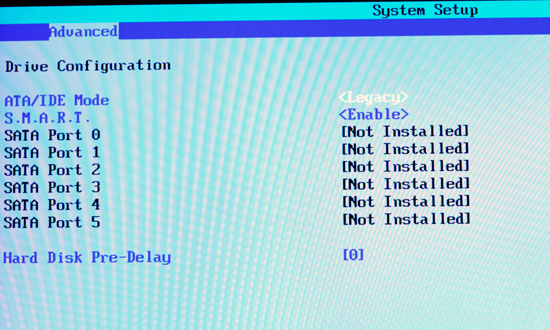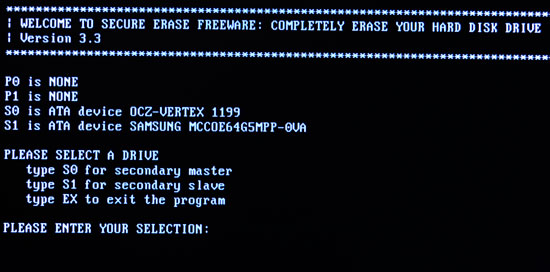The SSD Anthology: Understanding SSDs and New Drives from OCZ
by Anand Lal Shimpi on March 18, 2009 12:00 AM EST- Posted in
- Storage
Restoring Your Drive to Peak Performance
Based on my explanation there’s one sure-fire way to make your drive fast again. Formatting/deleting everything on the drive won’t work because those pages on the drive will remain full of data.
If you are doing a clean setup of your machine and want to restore your drive to its native state you’ll have to perform a secure erase. Intel distributed a tool with the first X25-M review kits called HDD ERASE. This tool will take any SSD and free every last page on the drive. Obviously you’ll lose all of your data but your drive will be super fast again!
In order for HDDERASE to work you need to have your SATA controller running in Legacy IDE mode, you can select this in your BIOS. Your drive will have to be connected to one of the first four SATA ports off of the controller.

Boot to a command prompt (I just use a bootable DOS image on my USB stick) and run the executable. Answer its questions carefully and with honor.



Tell it you would like to perform a secure erase (an extended one isn’t necessary) and when it asks you if you wish to view LBA 0 you can say no. Reboot your machine (don’t forget to set your SATA controller back to whatever mode you had it in before, e.g. RAID or AHCI), partition your drive and you’re back in business.
On a good SSD I don’t believe there’s a need to secure erase periodically, but whenever you format or re-image your drive, I’d recommend a secure erase since you’re killing all of your data anyway.










250 Comments
View All Comments
Jamor - Wednesday, March 18, 2009 - link
The best tech article I've ever read, and I've read a few.haze4peace - Wednesday, March 18, 2009 - link
Wow, excellent article and so much useful information in an easy to understand way. I have just recently been paying attention to SSDs and thanks to this article I am armed with the information to make the correct choice for my needs. Thanks AnandTech, its the deep and honest articles like these that keep me coming back for more.Alseki - Wednesday, March 18, 2009 - link
I just registered then simply to say, great article. Really informative and enjoyable to read.alexsch8 - Wednesday, March 18, 2009 - link
Anand,Thank you for this article, very informative.
Looking at the example you are giving with your self-manufactured SSD drive: If I save the DOC I use up a page. Based on what you are saying, if I make a change to that DOC, it would then be saved in the next page instead of overwriting the existing page? If that is true, then the File Allocation system (FAT or MFT) itself would contribute quite a bit to the 'filling up of pages' phenomena. Could you elaborate if the proposed file system for SSD addresses this?
Ytterbium - Wednesday, March 18, 2009 - link
Fantastic article, shame that the vendors blacklisted you for telling the truth and OCZ rock for working so hard to address issues.I'll be ordering my Intel SSD soon, I'll defintly consider the Summit when it comes out for my encoding rig as there sequental writes matter to me.
mindless1 - Wednesday, March 18, 2009 - link
Great even, but I've have to disagree with the significance of the passage that suggested the Indilinx controller makes data loss as bad on those SSD as on a conventional hard drive.The primary cause of data loss is mechanical or component failure, not power loss. If we want to consider power loss, it's not just the drive which is prone to lose data, the entire system memory suffers far more data loss than that.
Further, a sufficiently sized supercapacitor should keep the drive operating for a period of time beyond when the rest of the system would be operational, it could be sufficient for the controller to finish writing to flash all received data (or just use an UPS, that's what they're for?).
Second, I can't believe that OCZ only tests designs with HDTach and Atto, I think it more likely they knew of the problem but didn't expect anyone to find it so quickly, and felt the higher sequential speeds made it more marketable. This makes me feel that manufacturers, then online sellers should differentiate their drives with a standardized random read/write score.
What would be really nice is if the Indilinx based SSDs had an application available, similar to a HDD acoustic management bit changing app, that lets the owner set their own preference for IO versus sequential read performance.
gomakeit - Wednesday, March 18, 2009 - link
This is by far the BEST article on SSD I've ever read! Great job anand and yes I read every single word of it!MagicPants - Wednesday, March 18, 2009 - link
Don't they ever try using their own devices? One second of latency should slap any user in the face. It should be very easy for a manufacturer to build a system with their new technology put it in front of people and see what happens, but apparently they're not doing this.They wait for reviewers to do the work for them and then get upset when they find a problem.
What the manufacturers should be taking away from this article is:
1) Try your competitor's products
2) Try your own products
3) Try them in real life as opposed to synthetic tests
4) Compare everything you've tried and market the performance that matters
7Enigma - Thursday, March 19, 2009 - link
But that would make sense....and we know marketing rarely does.paulinus - Wednesday, March 18, 2009 - link
That art is great. Finally someone done ssd test's right, and said loud what we, customers, can get for that hefty pricetags.I've supposed that only choices are intel and new ocz's. Now I know, and big kudos for that.
Just need a bit more $$ for x25-m, it'll be ideal for heavy workstation use, and biggest vertex'll replace wd black in my aging 6910p :)